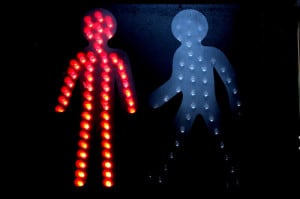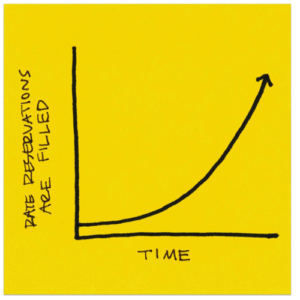Mailbox’s attempt at damage control came in the form of a blog post explaining their roll out plans. At the center of the plea for patience was what appeared to be a hand-drawn yellow post-it note. As if sketched in the nick of time to placate the angry mobs, an exponential curve showed that soon, the company would accept many more users. But unlike in the case of Facebook, frustrated customers punished Mailbox for the wait. They trashed the app by writing poor reviews despite never having actually used it.
As for Tempo, CEO Raj Singh said his app’s waitlist was a response to its unexpected popularity. In an email interview Singh wrote, “We mis-estimated demand for Tempo by 24X.” Expressing his regret, Singh continued, “There may have been some velvet rope effect but trust me, that was absolutely not the intention…We probably lost ~100K registered users as a result of the line.”
So why the difference in the response to Facebook versus Tempo or Mailbox? For one, it’s not clear things turned out all that bad. After all, Mailbox was snatched up by Dropbox in a rumoured $100 million acquisition and Tempo just raised a respectable wad of cash.
Nonetheless, as these examples show, scarcity made some people lust, while making others livid. But why? Here again, the 1975 cookie jar study provides some clues.
In the second part of their experiment, Worschel, Lee, and Adewole wanted to know what would happen to the perception of the value of cookies if they suddenly became scarce or abundant.
Groups of study participants were given either jars with two cookies or ten. Then, the people in the group with ten cookies suddenly had eight taken away. Conversely, those with only two cookies had eight new cookies added to their jars. How would the changes affect the way participants valued the cookies?
The researchers showed that consistent with the scarcity heuristic, the group left with only two cookies, rated them to be more valuable. However, those who got more cookies, experiencing sudden abundance by going from two to ten, actually valued the cookies the least. In fact, they valued the cookies even lower than those people who had started with ten cookies to begin with.
The study showed that a product can decrease in perceived value if it starts off as scarce then becomes abundant. Sound familiar? Take a look at the Mailbox post-it note graph again, that is exactly what the graph shows.





 This week, focused on the science behind how consumers make decisions.
This week, focused on the science behind how consumers make decisions.